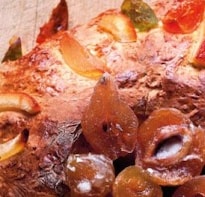Still in the holiday spirit? Why not celebrate Epiphany with a spin on a fruity traditional Spanish cake?
milk 160ml
clementine or small orange 1
lemon 1
butter 125g
sugar 125g
eggs 2
plain flour 600g
dried yeast 2 tsp
beaten egg mixed with a little milk 1
whole crystallised fruits about 6For the cream:
mascarpone 250g
whipped cream 200mlPut the water and milk into a saucepan. Grate the clementine and lemon finely, stir into the milk and water, then bring almost to the boil. Remove from the heat and leave to infuse until warm rather than hot. (You should be able to hold your finger in it for several seconds.)In a food mixer, fitted with the flat paddle attachment, cream the butter and sugar until soft, pale and light. Slowly and firmly beat in the eggs.In a separate large bowl, tip the dried yeast and a generous pinch of salt into the flour and mix well, then introduce the warm milk mixture, beating the liquid into the flour with a wooden spoon or your hands.With the mixer at a slow speed, introduce the yeasted flour mixture to the creamed butter, sugar and egg. (At this point the dough will seem a little unusual in its consistency, but bear with me.) Remove the dough from the machine, put a cloth or a piece of kitchen film over the top, then leave in a warm place for between an hour and an hour and half to rise.When the dough is light and well risen - it should be almost twice its original size - tip it out on to a deep floured board and work it into a thick sausage shape and then into a ring. Transfer to a baking sheet lined with baking parchment and brush with a little beaten egg and milk.Cut the fruit into large pieces, then push them down into the surface of the dough. Leave for 15 minutes in a warm place to regain its shape, then bake for 45 to 50 minutes until light brown. Leave on its tray to cool briefly before transferring carefully to a large serving dish or bread board.Cut into slices and serve with cardamom and vanilla cream below.
vanilla pod 1
sugar 2 tbsp
mascarpone 250g
softly whipped cream 200gBreak open the cardamom pods and pick out the black seeds inside, then crush them to a fine powder using a pestle and mortar. Split the vanilla pod lengthways and scrape out the black seeds within, add them to the cardamom and stir in the sugar. Set aside in a jar until you are ready to serve the cake.Pour the cream into a bowl and whip until thick, stopping before it stands in peaks. It should be soft enough to just fall off the spoon. Stir it into the mascarpone, taking great care not to over mix.Transfer the cream to a serving bowl, scatter over some of the spiced cream, then scatter the remainder over the cake, and serve.
Email Nigel at nigel.slater@observer.co.uk
Ring the changes: Nigel's take on roscón de reyes, a cake for Epiphany. Photograph: Jonathan Lovekin for the Observer
Advertisement
A cake for Epiphany
A large ring cake. You will need a large baking sheet lined with kitchen parchment. Serves 8-10.Advertisement
milk 160ml
clementine or small orange 1
lemon 1
butter 125g
sugar 125g
eggs 2
plain flour 600g
dried yeast 2 tsp
beaten egg mixed with a little milk 1
whole crystallised fruits about 6For the cream:
mascarpone 250g
whipped cream 200mlPut the water and milk into a saucepan. Grate the clementine and lemon finely, stir into the milk and water, then bring almost to the boil. Remove from the heat and leave to infuse until warm rather than hot. (You should be able to hold your finger in it for several seconds.)
Advertisement
Advertisement
Cardamom and vanilla cream
cardamom pods 15vanilla pod 1
sugar 2 tbsp
mascarpone 250g
softly whipped cream 200gBreak open the cardamom pods and pick out the black seeds inside, then crush them to a fine powder using a pestle and mortar. Split the vanilla pod lengthways and scrape out the black seeds within, add them to the cardamom and stir in the sugar. Set aside in a jar until you are ready to serve the cake.Pour the cream into a bowl and whip until thick, stopping before it stands in peaks. It should be soft enough to just fall off the spoon. Stir it into the mascarpone, taking great care not to over mix.Transfer the cream to a serving bowl, scatter over some of the spiced cream, then scatter the remainder over the cake, and serve.
Email Nigel at nigel.slater@observer.co.uk
Ring the changes: Nigel's take on roscón de reyes, a cake for Epiphany. Photograph: Jonathan Lovekin for the Observer
For the latest food news, health tips and recipes, like us on Facebook or follow us on Twitter and YouTube.
Advertisement
Tags:
